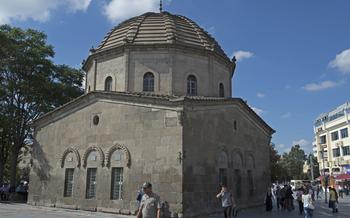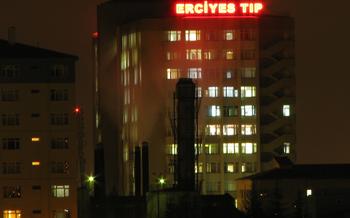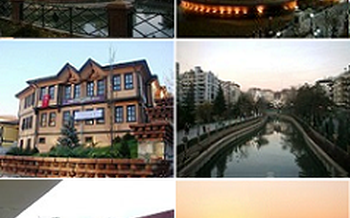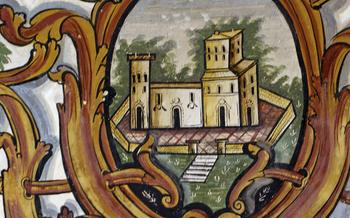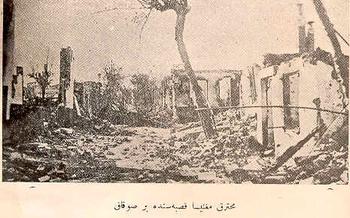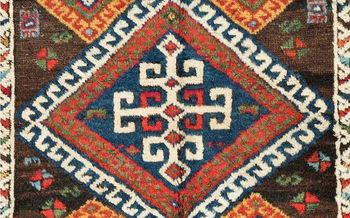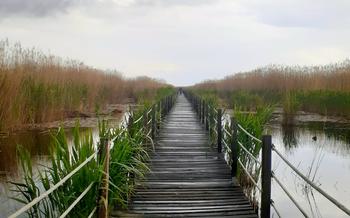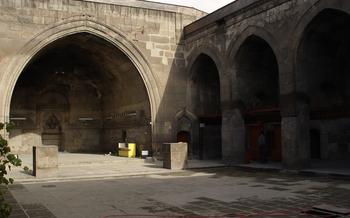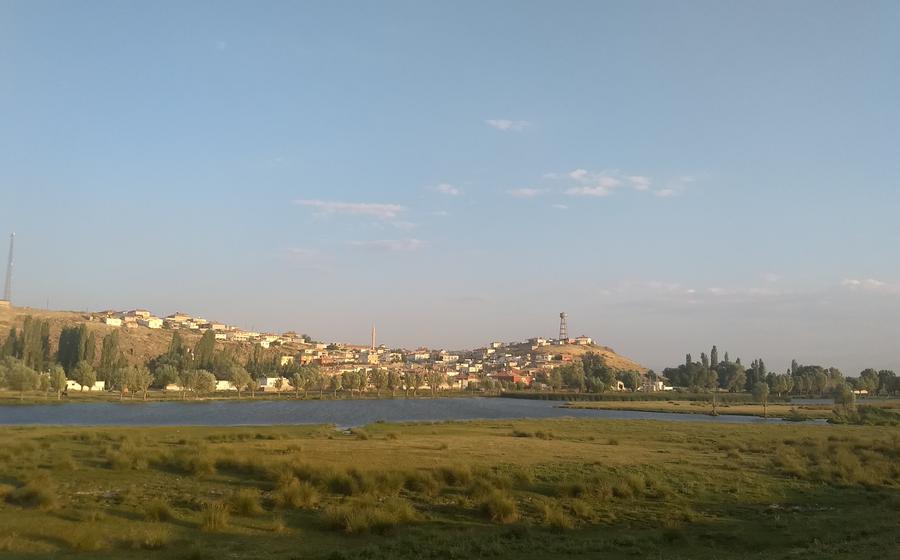
Ahi Evran Mosque and Tomb
- The Ahi Evran Mosque and Tomb: A Spiritual Haven
- Historical Significance: A Journey Through Time
- Ahi Evran: The Man, the Legend
- Architectural Masterpiece: A Blend of Styles
- Prayer Hall: A Place of Serenity and Devotion
- Minaret: A Symbol of Faith and Guidance
- Pilgrimage Site: A Sacred Destination
- Restoration Efforts: Preserving a Legacy
- Local Customs and Traditions: A Glimpse into Turkish Culture
- Festivals and Celebrations: A Time for Joy and Unity
- Guided Tours: Unveiling the Mosque's Secrets
- Photography Tips: Capturing the Mosque's Beauty
- Insider Tip: Discovering Hidden Gems
The Ahi Evran Mosque and Tomb: A Spiritual Haven
In the heart of Kayseri, a city steeped in history and culture, stands the revered Ahi Evran Mosque and Tomb, a spiritual haven that draws pilgrims and visitors from far and wide. This architectural masterpiece, constructed during the Seljuk period, holds immense significance as the resting place of Ahi Evran, the legendary founder of the Ahi Order. The mosque, with its intricate carvings, exquisite tilework, and serene ambiance, serves as a testament to Ahi Evran's teachings of honesty, integrity, and social responsibility. As you step through the gates of this sacred space, you will be enveloped by a sense of tranquility and awe, inspired by the legacy of Ahi Evran and the enduring spirit of Turkish culture.
Historical Significance: A Journey Through Time
Kayseri, a city steeped in history, boasts a rich tapestry of civilizations that have left their indelible mark on the region. The Ahi Evran Mosque and Tomb stands as a testament to Kayseri's pivotal role in the development of Turkey. Constructed during the Seljuk period, the mosque exemplifies the architectural prowess of this era. The Seljuks, known for their mastery in stonework and intricate carvings, left their artistic legacy etched into the mosque's facade.
During the reign of Sultan Alaeddin Keykubad I, the mosque underwent significant expansion, reflecting the growing importance of Kayseri as a trade and cultural hub. The mosque's strategic location along trade routes facilitated the spread of ideas and innovations, contributing to the city's economic prosperity.
Ahi Evran, the mosque's namesake, played a pivotal role in shaping the social and economic landscape of Kayseri. As the founder of the Ahi Order, he established a code of ethics for merchants and artisans, emphasizing honesty, integrity, and social responsibility. His teachings resonated throughout the region, influencing trade practices and fostering a spirit of cooperation among craftsmen.
Over the centuries, the mosque has undergone several restoration efforts, ensuring its preservation as a living testament to Kayseri's rich history. These efforts have been instrumental in maintaining the mosque's structural integrity and preserving its architectural features, allowing visitors to experience the grandeur of this historical site.
Ahi Evran: The Man, the Legend
Ahi Evran, the founder of the Ahi Order, was born in the 12th century in the Anatolian city of Kayseri. He was a man of great wisdom and piety who dedicated his life to promoting honesty, integrity, and social responsibility. Ahi Evran believed that trade and craftsmanship should be based on ethical principles, and he established the ahilik system, a code of conduct for merchants and artisans.
Ahi Evran's teachings emphasized the importance of trust, fairness, and cooperation. He believed that businesses should operate with honesty and integrity, and that customers should be treated with respect. He also stressed the importance of social responsibility, encouraging his followers to give back to their communities and help those in need.
The ahilik system, which was based on Ahi Evran's teachings, became widespread throughout the Ottoman Empire. It played a crucial role in regulating trade and craftsmanship, and it helped to create a strong sense of community among merchants and artisans. Ahi Evran's legacy continues to this day, and his teachings remain an inspiration to people all over the world.
Architectural Masterpiece: A Blend of Styles
The Ahi Evran Mosque stands as a testament to the harmonious fusion of Seljuk and Ottoman architectural styles. The exterior facade is adorned with intricate carvings and calligraphy, showcasing the exceptional craftsmanship of the Seljuk period. The pointed arches, domes, and minarets reflect the grandeur of Ottoman architecture, blending seamlessly with the Seljuk elements.
Inside the mosque, the spacious courtyard leads to the prayer hall, which features a vast central dome supported by massive columns. The mihrab, indicating the direction of Mecca, is adorned with intricate tilework and calligraphy, creating a focal point for worshippers. The walls are adorned with verses from the Quran, adding to the spiritual ambiance of the prayer hall.
The minaret, a symbol of faith and guidance, rises high above the mosque, adorned with stunning tilework and calligraphy. Its intricate designs and patterns showcase the artistry of the Ottoman period. The minaret serves as a reminder of the mosque's role in calling the faithful to prayer, its melodious sound echoing throughout the city.
Prayer Hall: A Place of Serenity and Devotion
The prayer hall of the Ahi Evran Mosque is a vast and awe-inspiring space, capable of accommodating thousands of worshippers within its sacred walls. As you step inside, a sense of serenity and devotion envelops you, inviting you to immerse yourself in spiritual contemplation. The intricate mihrab, or prayer niche, stands as the focal point of the hall, indicating the direction of Mecca with its exquisite craftsmanship. The mihrab is adorned with intricate carvings and calligraphy, reflecting the artistry and devotion of the mosque's builders.
The atmosphere within the prayer hall is one of tranquility and peace, conducive to deep reflection and communion with the divine. The soft light filtering through the stained-glass windows casts a warm glow, illuminating the rows of prayer rugs that line the floor. The air is filled with the gentle murmur of prayers and the rustle of clothing as worshippers bow and prostrate in devotion.
The prayer hall bears witness to centuries of heartfelt supplications and spiritual journeys. Its walls hold the echoes of countless prayers, whispered hopes, and expressions of gratitude. As you stand in this sacred space, you can't help but feel a profound connection to the generations of believers who have come before you, seeking solace, guidance, and inner peace within these hallowed walls.
Minaret: A Symbol of Faith and Guidance
The towering minaret of the Ahi Evran Mosque stands tall, reaching towards the heavens, serving as a prominent symbol of faith and guidance for the people of Kayseri. Its intricate tilework and calligraphy, a testament to the artistry and devotion of its creators, adorn the minaret, making it a visually captivating sight. The minaret's primary function is to serve as a platform for the call to prayer, echoing throughout the city, inviting the faithful to come together for their daily prayers. Ascending the minaret's narrow staircase rewards visitors with breathtaking panoramic views of Kayseri, allowing them to appreciate the city's rich tapestry of history and culture from a unique perspective.
Pilgrimage Site: A Sacred Destination
The Ahi Evran Mosque and Tomb holds immense significance as a revered pilgrimage site for Muslims from Turkey and beyond. Many believe that visiting this sacred place brings blessings and good fortune, attracting a steady stream of pilgrims seeking spiritual guidance and healing. The mosque's reputation as a holy site has made it a popular destination for those seeking solace, tranquility, and a deeper connection with their faith.
During religious festivals and special occasions, the mosque bustles with activity as pilgrims from various regions converge to celebrate and pay homage to Ahi Evran. The atmosphere is electric, filled with the sounds of prayers, supplications, and the recitation of verses from the Quran. These festivals provide a unique opportunity for pilgrims to connect with fellow believers, share stories and experiences, and bask in the spiritual aura that permeates the mosque.
Restoration Efforts: Preserving a Legacy
The Ahi Evran Mosque and Tomb has undergone extensive restoration efforts to preserve its historical and cultural heritage. Recognizing the importance of maintaining the mosque's integrity, government agencies and local communities have collaborated to restore the mosque to its former glory.
The restoration process involved meticulous attention to detail, ensuring that the mosque's original features were preserved while incorporating modern techniques to enhance its structural stability. Skilled artisans and craftsmen employed traditional methods to restore the intricate carvings, calligraphy, and tilework that adorn the mosque.
One of the main challenges faced during the restoration was the need to strike a balance between preserving the mosque's authenticity and incorporating necessary updates. The restoration team carefully assessed each element of the mosque, ensuring that any changes made were in line with the mosque's original design and historical significance.
The successful restoration of the Ahi Evran Mosque and Tomb stands as a testament to the dedication and expertise of the individuals involved. Their efforts have ensured that this architectural masterpiece continues to serve as a beacon of faith and a symbol of Kayseri's rich cultural heritage.
Local Customs and Traditions: A Glimpse into Turkish Culture
When visiting the Ahi Evran Mosque and Tomb, it is important to be mindful of local customs and traditions to ensure a respectful and meaningful experience. Dressing modestly is expected, with clothing that covers the shoulders and knees. Upon entering the mosque, it is customary to remove one's shoes and place them neatly on the designated shelves. Visitors should also be mindful of their behavior, maintaining a quiet and respectful demeanor while inside the mosque.
Interacting with locals is a wonderful way to gain insights into Turkish culture. Visitors may encounter friendly locals who are eager to share their knowledge and experiences. It is important to be open and respectful when engaging in conversations, avoiding sensitive topics or making assumptions. By embracing local customs and traditions, visitors can deepen their understanding of Turkish culture and create a truly immersive experience.
Festivals and Celebrations: A Time for Joy and Unity
The Ahi Evran Mosque is not just a place of worship; it also serves as a venue for vibrant festivals and celebrations that bring the local community together. These events showcase the rich cultural heritage of Kayseri and offer a glimpse into the Turkish way of life.
One of the most significant celebrations held at the mosque is the annual Ahi Evran Festival. This festival commemorates the life and teachings of Ahi Evran and attracts visitors from all over Turkey. During the festival, the mosque is adorned with colorful decorations, and the air is filled with the sounds of traditional music and dance. Visitors can witness mesmerizing performances, indulge in delicious Turkish cuisine, and participate in various cultural activities.
Another popular event is the Mevlid-i Nabi, which celebrates the birth of Prophet Muhammad. During this festival, the mosque hosts special prayers, recitations, and sermons. The mosque's courtyard transforms into a lively gathering place, where locals come together to share food, laughter, and stories.
These festivals and celebrations provide a unique opportunity to experience the warmth and hospitality of the Turkish people. Visitors can immerse themselves in the local culture, make new friends, and create lasting memories.
Guided Tours: Unveiling the Mosque's Secrets
To delve deeper into the rich history and significance of the Ahi Evran Mosque and Tomb, guided tours are highly recommended. Knowledgeable local guides are available to provide insightful commentary and unveil the hidden secrets of this architectural masterpiece.
These tours, offered in various languages, offer a comprehensive exploration of the mosque's architectural features, symbolism, and historical context. Guides share fascinating stories and anecdotes about the life of Ahi Evran, the founder of the Ahi Order, and his teachings on honesty, integrity, and social responsibility.
By participating in a guided tour, visitors gain a deeper understanding of the mosque's role as a pilgrimage site and its importance in Turkish culture. Guides explain the significance of the mosque's unique blend of Seljuk and Ottoman architectural styles and point out intricate details that might otherwise go unnoticed.
Whether you are a history buff, an architecture enthusiast, or simply seeking a spiritual connection, a guided tour of the Ahi Evran Mosque and Tomb is an enriching experience that will leave you with a lasting appreciation for this sacred site.
Photography Tips: Capturing the Mosque's Beauty
The Ahi Evran Mosque is a photographer's paradise, with its intricate details, vibrant colors, and stunning architectural features. Here are some tips to help you capture the mosque's beauty:
Golden Hour Magic: Plan your visit during the golden hours of sunrise or sunset to capture the warm, diffused light that casts a magical glow on the mosque's exterior.
Wide-Angle Wonders: Use a wide-angle lens to capture the mosque's grandeur in its entirety. Experiment with different angles to create dynamic compositions.
Detail Delight: Get up close and personal to capture the intricate carvings, calligraphy, and tilework that adorn the mosque's facade.
Symmetry and Balance: Take advantage of the mosque's symmetry and balance to create visually pleasing compositions.
Interior Serenity: Step inside the mosque to capture the serene atmosphere of the prayer hall, with its high ceilings, elegant arches, and intricate mihrab.
Respectful Approach: Remember to be respectful of worshippers and avoid taking photographs during prayer times.
Panoramic Views: Climb to the top of the minaret for breathtaking panoramic views of Kayseri and the surrounding landscape.
Local Life: Capture the essence of the mosque by photographing the locals who come to pray, socialize, or simply find solace within its walls.
Storytelling Snapshots: Look for moments that tell a story, such as people praying, children playing in the courtyard, or visitors admiring the mosque's beauty.
Insider Tip: Discovering Hidden Gems
When visiting the Ahi Evran Mosque and Tomb, don't miss the opportunity to explore the surrounding area and discover hidden gems. Just a short walk away, you'll find the impressive Kayseri Castle, a magnificent structure that offers panoramic views of the city. Climb to the top of the castle walls to capture breathtaking photos of the cityscape, with the mosque's minaret standing tall in the background.
After exploring the castle, immerse yourself in the vibrant local culture by indulging in the delicious Turkish cuisine. Kayseri is renowned for its mouthwatering dishes, such as the traditional mantı (Turkish dumplings) and the flavorful künefe (shredded filo dough dessert with cheese). Visit local restaurants to savor these culinary delights and experience the warm hospitality of the Turkish people.
For those interested in shopping, Kayseri's vibrant markets and bazaars are a treasure trove of authentic souvenirs. From traditional handicrafts to colorful textiles and spices, you'll find a wide variety of unique items to take home as mementos of your trip. Be sure to haggle with the friendly vendors to get the best prices and immerse yourself in the lively atmosphere of these bustling marketplaces.
Exploring the hidden gems around the Ahi Evran Mosque and Tomb will enrich your visit and provide a deeper understanding of Kayseri's rich history and culture. Embrace the opportunity to step off the beaten path and discover the secrets that this fascinating city holds.
